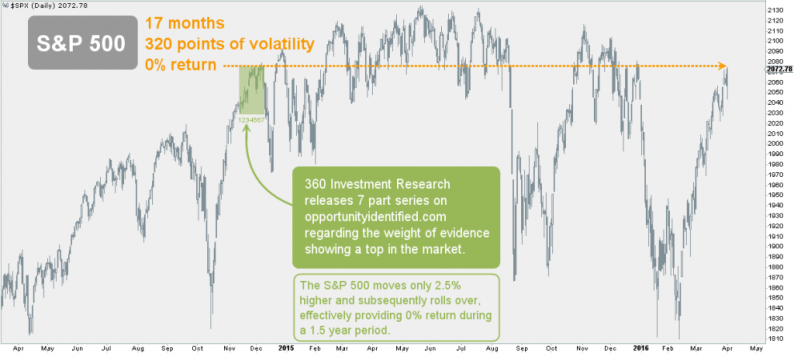Back in November and December of 2014, we released a 7 part series highlighting the weight of evidence piling up against U.S. stocks. In summary, our research showed a market top was upon us. If you weren’t with us back then, you can catch up and dig into our methods using the links below.
This research proved timely as U.S. equities subsequently stalled, moving sideways for the past 1.5 years.

To show the importance of our findings, as well as highlight its prescience, here is the S&P 500 from a bigger perspective.

If you were reading our research back then, we hope you used it to your advantage. All that being said, this isn’t just a puff-our-chest piece. The U.S. stock market is at an important juncture and we want you to see what we see. As we’ve highlighted in the past, corrections happen in one of two ways: through price -or- through time. It is too early to tell, but 1.5 years would qualify as a correction through time if price can move upward through current levels and sustain new highs. At the same time, further correction through price is still on the table. If the S&P 500 cannot breach this level and move on to new highs, it is very likely a correction between 5-15% will take place.
Here’s a daily chart of the S&P 500 (our U.S. stock market proxy) showing just how important this current price level is to market participants.

The area between 2072 and 2134 has seen sellers show up en masse in the past. In addition, this important index needs to overcome the downward green trendline annotated on the chart above. This dual resistance should be difficult to overcome in the short term. However, price knows more than we do. If price can overcome this area of supply, it would signify buyers’ willingness to test all time highs (2134) from the Summer of 2015. This rally from the early February lows has been fast and fierce. Yet, from a short-term perspective, it is long in the tooth. A consolidation or pullback here could be healthy. At the same time, if we ask ourselves the question, “is this where we want to put new money to work?” We think the answer is a simple, no.













Leave A Comment